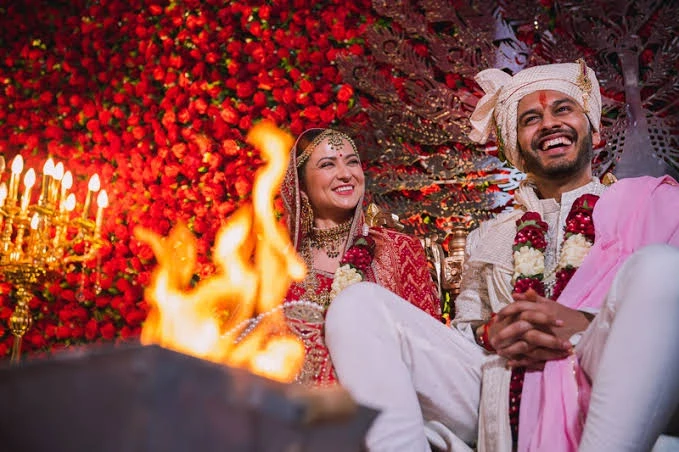
The Essence Of Delhi’s Traditional Marriage.
Traditional marriages in Delhi are an elaborate affair, reflecting the city's historical grandeur and cultural diversity. The ceremonies are a grand spectacle, involving a series of rituals and celebrations that often span several days. These marriages are not just unions of two individuals but are seen as the coming together of two families, marking the beginning of a new chapter in their lives.
Pre-Wedding Rituals: Setting the Stage
Roka Ceremony: The Roka is one of the earliest rituals, symbolizing the formal announcement of the couple’s intention to marry. It is often a simple, intimate gathering where both families meet and exchange gifts, blessings, and sweets.
Engagement Ceremony (Sagai or Tilak): This ceremony is marked by the exchange of rings and the application of tilak (a ceremonial mark) on the groom's forehead by the bride’s family. It signifies the official commitment of the couple and the families.
Mehendi Ceremony: One of the most colorful pre-wedding events, the Mehendi ceremony involves the application of intricate henna designs on the bride's hands and feet. This ritual is accompanied by traditional songs and dances, creating a lively and joyous atmosphere.
Sangeet: A night of music and dance, the Sangeet is an opportunity for both families to come together and celebrate through performances, singing, and dancing. It’s a lively, energetic event that brings everyone into the celebratory spirit.
Wedding Day Rituals: The Main Event
Baraat: The wedding day begins with the Baraat, a vibrant procession led by the groom and his family, moving towards the bride’s home or wedding venue. The groom rides a decorated horse or a car, accompanied by music, dancing, and celebratory festivities.
Jaimala/Varmala: Upon arrival, the bride and groom exchange floral garlands in the Jaimala or Varmala ceremony. This act symbolizes their acceptance of each other and marks the official start of their union.
Kanyadaan: One of the most poignant rituals, Kanyadaan involves the bride’s father giving her away to the groom. This ritual signifies the transfer of responsibility and is a deeply emotional moment in the ceremony.
Phere (Saptapadi): The couple circles the sacred fire (Agni) seven times in the Phere ceremony, each round representing a vow and a promise. These vows encompass various aspects of marital life, including love, loyalty, and support.
Sindoor and Mangalsutra: The groom applies sindoor (vermilion) on the bride’s forehead and ties the mangalsutra (a sacred necklace) around her neck. These rituals signify the bride’s transition into a married woman and the groom’s commitment to her.
Post-Wedding Rituals: Celebrating the Union
Vidaai: The Vidaai is an emotional farewell given to the bride by her family as she departs to start a new life with her husband. It is a heartfelt ritual, symbolizing the bride’s transition from her parental home to her new family.
Griha Pravesh: Upon arrival at the groom’s home, the bride is welcomed with a special ceremony called Griha Pravesh. This ritual involves the bride stepping into her new home, often with a ritualistic gesture like stepping over a rice pot, symbolizing prosperity and abundance.
Reception: A grand reception follows, where the newlyweds are introduced to extended family, friends, and the community. It’s a celebration of the union with music, dancing, and a feast, marking the end of the wedding festivities.
Attire and Aesthetics
Traditional wedding attire in Delhi is nothing short of spectacular. Brides typically don elaborate sarees or lehengas adorned with intricate embroidery and embellishments. The groom usually dons a sherwani or a traditional kurta-pajama, complemented by a turban. The attire is often completed with exquisite jewelry and accessories, reflecting the opulence and cultural richness of the occasion.
Cultural Significance and Modern Adaptations
While the traditional marriage ceremonies in Delhi are deeply rooted in cultural practices, there is also a growing trend of modern adaptations. Many families now blend traditional rituals with contemporary elements, making the ceremonies more personalized and reflective of individual preferences.
Conclusion
Traditional marriages in Delhi are a grand celebration of culture, family, and heritage. They encapsulate the essence of the city’s rich history while embracing the joy and excitement of new beginnings. Each ritual, from the Roka to the Vidaai, is a testament to the depth and significance of marital unions in Delhi’s cultural fabric. As Delhi continues to evolve, its traditional marriages remain a beautiful and enduring symbol of the city’s timeless charm and vibrant traditions.

Related Posts